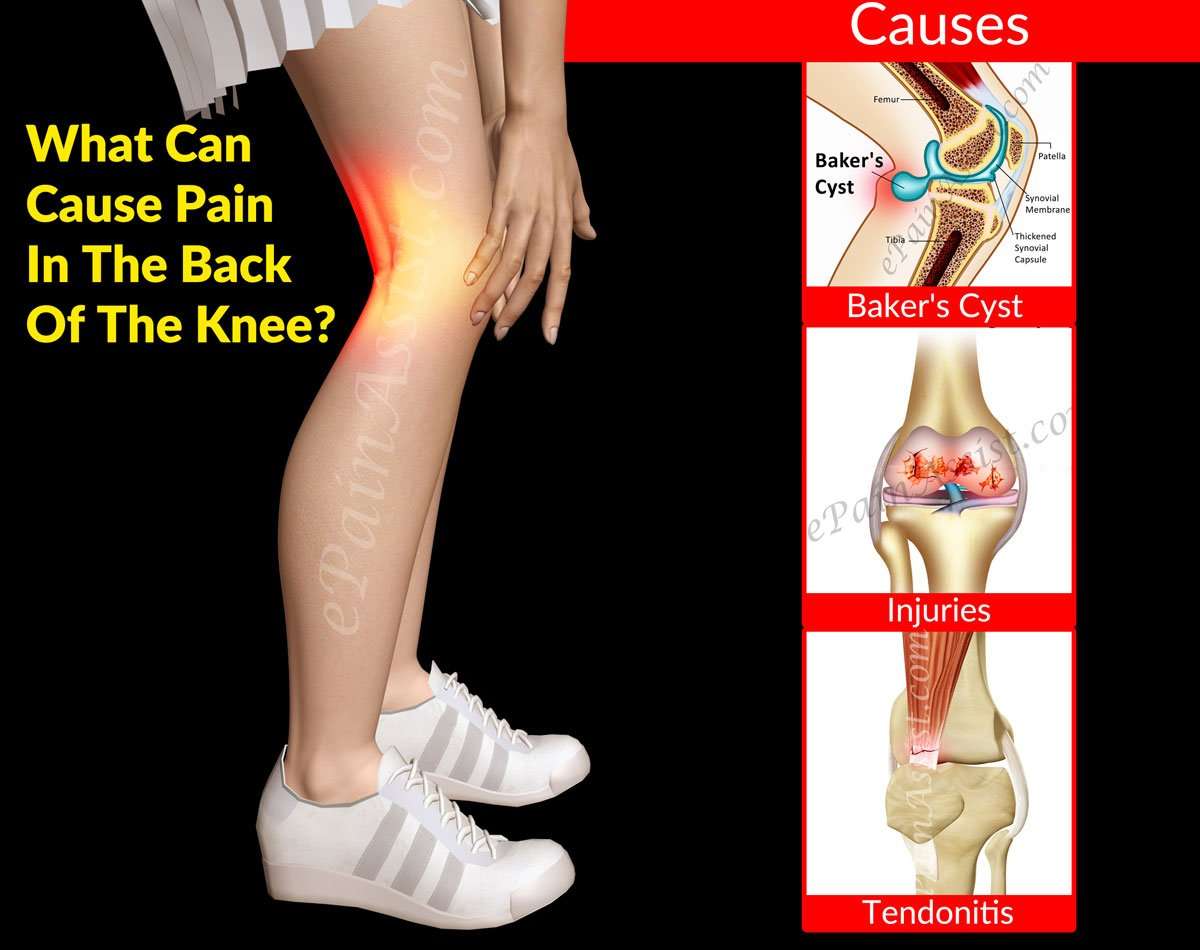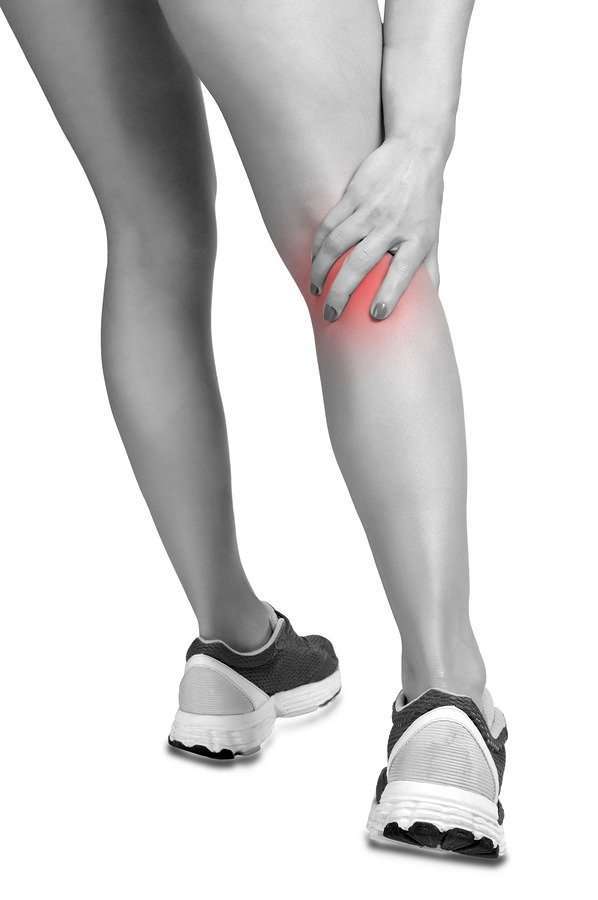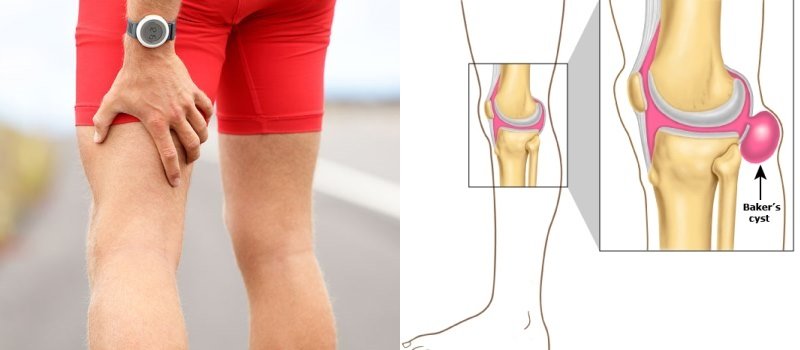Types Of Pain Behind The Knee
There are a number of health conditions that may result in pain behind your knee. Two common conditions that cause it are a:
- posterior cruciate ligament injury
- popliteal cyst, also called Bakers cyst
A posterior cruciate ligament injury can happen if you overstretch or tear this ligament, which runs across your knee from your thigh to your shin bone. It often results from a heavy blow to the front of your knee while its bent. This can happen if you hit your knee on the dashboard during a car accident, or over-straighten your leg and bend your knee backwards. Doctors call this hyperextension.
A cyst is a collection of fluid or material inside a thin layer of tissue. A popliteal cyst is a cyst in the shallow pit at the back of your knee. Its often linked to other conditions that affect the knee, such as osteoarthritis, rheumatoid arthritis, or cartilage injuries. If you injure your knee, it can cause a collection of fluid to develop within your knee. Sometimes you can feel this in the depression at the back of your knee.
Osteoarthritis of the knee is another common cause of knee pain. The smooth, shiny cartilage that lines your knee joint becomes worn and rough. This causes pain and damages your knee over time. It mostly affects people over 50. The older you are, the more likely you are to get it.
Does Sciatica Cause Pain Behind The Knee
Sciatica pain radiates along the sciatic nerve, usually from the low back, down the buttocks, into the thigh and leg. One hallmark of classic sciatica is the pain and symptoms are felt below the knee and sometimes into the foot and great toe. Usually, sciatica only affects one side of the lower body.
Reasons Why Your Knee Hurts When Straight
If the back of your knee hurts when you straighten it, several conditions may be responsible. A physician can easily diagnose some, while others require special diagnostic equipment to fully understand the condition.
Some of the causes of posterior knee pain are:
- Posterior Cruciate Ligament Injury
- The PCL and the ACL are the ligaments that form the X structure found inside the knee joint. The PCL is responsible for preventing the shin bone from moving backward excessively relative to the thigh bone. It is the strongest ligament of the knee and provides stability and support during walking and running.
- The most common cause of a PCL injury is a force applied to the front of the knee. A PCL injury often results from landing on the knee when falling or an automobile accident leading to a dashboard injury where the knee impacts the vehicles dashboard.
- The symptoms of a PCL injury include immediate pain and swelling, stiffness, knee instability, and difficulty in walking.
- Deep Vein Thrombosis
- When the blood passes slowly through the deep vein at the back of the leg, a clump of blood cells could form, resulting in DVT. DVT is a potentially life-threatening condition as the clot can become dislodged and enter the bloodstream. When the clot reaches the lungs, it can cause blockage resulting in a condition called pulmonary embolism.
- The symptoms of DVT include throbbing or cramping pain, swelling, redness, warmth and tenderness in the affected area.
Read Also: What Is Nano Knee Replacement Surgery
Why Does My Hamstring Hurt Behind My Knee
Hamstring tendonitis occurs when the soft tissues that connect the muscles of the back thigh to the pelvis, knee, and lower legs become inflamed. Tendonitis is often brought on by overuse and causes acute, or immediate, pain that decreases with rest and minor first aid.
Leg Track Triggering Muscular Tissue Pain As Well As Swelling Behind The Knee

A condition called tennis leg can also create discomfort in the back of the leg behind the knee.
Tennis leg is related to damage to the gastrocnemius where damage to the muscle and soleus muscle in the calf bone triggers an accumulation of fluid.
According to the journal Instance Radiology Reports, leg tennis is typically the outcome of sporting activities injuries. Damage to the calf bone muscle mass can trigger swelling and discomfort in the back knee.
Also Check: How Long After Knee Replacement Can You Fly
What Is Behind Knee Pain
Behind is discomfort or soreness behind the knee joint. It may occur with or without movement and can be severe enough to limit movement. People may describe behind knee pain as discomfort, inflammation, increased warmth or burning, soreness, stiffness, or pain.
Behind knee pain is a common sign of a Bakers cyst, which is a buildup of synovial fluid behind the knee. Synovial fluid lubricates the joints and reduces friction between the joint cartilages. The symptoms associated with a Bakers cyst tend to come and go, and the condition will not cause any long-term damage to the knee.
However, behind knee may be a symptom of deep vein thrombosis , which is a serious and life-threatening condition. The blood clot can break loose and cause a in the lung, a heart attack, or even . Deep vein thrombosis has similar symptoms to a Bakers .
If you experience pain behind the knee and calf with painful swelling and bruises, seek immediate emergency medical care. If your symptoms persist or cause you concern, contact a medical professional.
What Is Pain Behind The Knee
Since the knee is the largest and most complex joint in the body, it makes sense that it might hurt sometimes. Although knee pain is a common complaint, it is less common behind the knee.
Pain in the back of the knee is called posterior knee pain, and it can have a variety of causes. Occasionally, posterior knee pain is “referred” from the front of the knee or the spine.
Read Also: How Much Does Aflac Pay For Knee Surgery
How Do You Treat Hamstring Pain Behind The Knee
Whats the Treatment for a Hamstring Strain?
F Get The Right Footgear
Often not taken seriously, you must buy footwear that gives your feet comfort during movement. That means acquiring insoles that provide conducive support to your knees, heel, and foot arch.
This shouldnât bother you much now as there are many shops offering gait analysis. The best part is that many shops do it for free!
Gait analysis helps assess your full process of walking and running. Through that same test, youâll also know whether you have any hidden biomechanical abnormality.
After the whole procedure ends, the shoe store now can help you pick a shoe befitting your natural gait and movement.
Also Check: Nano Knee Surgery Cost
A Swelling At The Back Of The Knee And Calf Causing Pain And A Feeling Of Tightness When Straightening The Leg
This may be due to a Bakers Cyst, which is an accumulation of synovial fluid in the popliteal fossa. The synovial fluid is over-produced, due often to a trauma to the knee or in conditions such as arthritis. The cyst may clear up on its own, but if not it is advisable to visit the doctor. Swelling in the knee joint due to extra synovial fluid being produced also occurs due to accidental damage to the knee or when osteoarthritis is present.
Also Check: How Long Does Sciatica Pain Last
Posterior Cruciate Ligament Injury
The posterior cruciate ligament is the ACLs partner. Its another band of tissue that connects your thighbone to your shinbone and supports your knee. However, the PCL isnt as likely to get injured as the ACL.
You can injure the PCL if you take a hard blow to the front of your knee, such as in a car accident. Sometimes injuries occur from twisting the knee or missing a step while walking.
Stretching the ligament too far causes a strain. With enough pressure, the ligament can tear into two parts.
Along with pain, a PCL injury causes:
- swelling of the knee
- trouble walking
- weakness of the knee
Rest, ice, and elevation can help a PCL injury heal faster. You might need surgery if youve injured more than one ligament in your knee, have symptoms of instability, or you also have cartilage damage.
You May Like: How To Reduce Swelling In Knee Quickly
Bakers Cyst And Pain In The Back Of The Knee
A Bakers cyst is a fluid-filled pocket in the back of the knee. Bakers cysts are a common cause of painful swelling. If the cysts are small, they do not create much discomfort.
A Bakers cyst can grow larger. If a cyst becomes large, it can put pressure on the muscles, blood vessels, and nerves behind the knee and can cause discomfort. Most people with a Bakers Cyst will also have osteoarthritis.
In most instances, treatments to diminish the swelling associated with arthritis will help reduce the pain and swelling from the cyst. In the majority of cases, these cysts are not dangerous. An ultrasound can usually tell if you have a simple cyst versus something more complex that warrants further evaluation with an MRI. If the Bakers cysts are huge, then one treatment alternative is to have the fluid drained. While that will result in relief of pain, the fluid might come back again.
Read Also: Pregnant Belly Symptoms
Possible Causes Of Pain Behind The Knee On Back Of Leg

There are some possible causes that may lead to pain behind the kneecap. Reading through the symptoms will help you determine which one out of these causes might be the one causing your behind the knee pain and thus, help find out the most possible cause of the problem.
Recommended Reading: How Do You Tell If Your Wrist Is Broken
Read Also: Best Knee Brace For Basketball Meniscus
What Causes A Baker’s Cyst
Knee damage caused by a sports injury or a blow to the knee can lead to a Baker’s cyst developing.
A Baker’s cyst can also sometimes occur if you have a health condition such as:
- osteoarthritis usually caused by age-related “wear and tear” of joints it particularly affects the knees, hips, hands and big toe
- inflammatory arthritis including rheumatoid arthritis, which is a less common type of arthritis and is caused by the immune system attacking the joints
- gout a type of arthritis that usually affects the big toe and is caused by a build-up of the waste product uric acid in the blood
Baker’s cysts usually develop in people aged 30 to 70, although they can affect people of any age, including children.
What Causes Pain Behind The Knee And Calf
Some causes of pain behind the knee and calf are deep vein thrombosis, tendinitis, muscle cramp and a Bakers cyst. Although these are common conditions that may cause pain symptoms, there can be other medical issues that lead to pain in these leg regions, such as an infection or knee sprain, as noted by WebMD.
Deep vein thrombosis can occur if a blood clot forms in a vein located in the calf area. This can cause symptoms, such as pain and inflammation in this region, as stated by Mayo Clinic. A blood clot in the lower extremities can travel to the lungs, causing a pulmonary embolism, a complication of DVT.
Knee sprains, knee infections, tendinitis and muscle cramps are different types of conditions that can cause pain at the back of the calf or knee area. For example, tendinitis, an inflammation of the tendons, can affect the calf muscles. A treatment option for tendinitis is prescribed anti-inflammatory medications, according to WebMD.
A Bakers cyst is a pocket or collection of synovial fluid that forms at the back of the knee. Although some patients may experience pain, others do not. However, if the cyst ruptures, it can lead to inflammation and bruising at the back of the knee and calf regions. Some causes, which can lead to a cyst formation in this area, are arthritis and a knee cartilage tear, as stated by the National Institutes of Healths MedlinePlus.
Don’t Miss: How To Whiten Knees And Elbows
Diagnosis Of Pain Behind The Knee
Your doctor will examine your knee and ask about your medical history and symptoms, including:
- the type of pain you have, when it started and whether it comes and goes
- how active you are
- any activity, accident or injury that could have caused it
If they suspect a posterior cruciate ligament injury, they may refer you to have an X-ray or a magnetic resonance imaging scan. If you have signs of a popliteal cyst, your doctor may suggest you have an ultrasound scan.
I Am Training For A Marathon And Have Started To Feel Pain Behind My Knee Whenever I Run Do I Need To Rest It Or Do I Need Treatment
If you experience pain behind the knee while running, it is better to rest and observe other symptoms that may develop. Because there are many reasons for knee pain, it is always best to seek the advice of a doctor or a physical therapist.
Resting the affected leg, taking pain medication, and refraining from high-impact activities can be enough to manage most conditions affecting the knee. However, if the pain and swelling do not resolve on the following day or worsen, or if you develop other symptoms such as redness and warmth in the affected area, you need to consult your doctor to obtain a proper diagnosis. Always remember that the earlier the injury gets treated, the better the healing and the faster you can return to your usual activities.
Don’t Miss: How To Get Rid Of Knee Fat And Cellulite
Torn Anterior Cruciate Ligament
You hear a pop and can’t move after you suddenly change direction — often while playing soccer, football, or basketball. You may have torn your ACL, which connects the femur and the tibia and prevents the tibia from moving too far forward. Your knee will hurt and swell and feel unstable.
You can tear or strain any of the tissues that hold your knee together: Ligaments connect bones to each other tendons connect muscle to bone. Irritated tendons from using them too much? That’s tendinitis.
Is Your Calf Pain Due To A Pulled Calf Muscle Or Something Else
Sudden calf pain during sport is often due to a calf tear or pulled calf muscle. A calf tear is also known as a calf strain or tennis leg as it is common in active people especially athletes.
However, the cause of calf pain could be due to something else including Achilles tendon tear, blood clot, blood vessel swelling , or Bakers cyst. In general, it is important to see your doctor to confirm the diagnosis of a pulled calf muscle or tennis leg.
You May Like: Can You Use An Inversion Table After Knee Replacement
Knee Pain Caused By Nerve Aggravation
This is an incredibly common cause for pain in the back of your knee. As an official diagnosis, it refers to aggravation or compression of the sciatic nerve .
Most often, sciatica is caused by compression of the nerve roots in either your lower back or from soft tissue in the buttocks. People often describe the sensation as a pain that travels or shoots down their limbs, commonly hitting that tender spot behind the knee.
Sciatica is typically diagnosed in your 50s, though its possible for it to start as early as your 20s or 30s. Research estimates that, on average, you can have up to a 40% chance of experiencing sciatica at some point in your life.
Luckily, though, since its a common diagnosis that afflicts a wide population, theres plenty of research surrounding methods for alleviating that radiating pain.
The most effective solution is to seek physical therapy. Your treatment will likely focus on improving movement patterns that is, working on your movement during activities that compress or load the lower back. Depending on your general lifestyle habits, this could include anything from stretching to core strengthening, or lifting education and manual manipulation of the tissues.
Treatment Of Knee Pain Caused By Sciatica

If knee pain is caused by sciatica, treatment is required. This is accomplished by focusing on the underlying cause. And symptoms can be treated with self-care or medications. You can also relieve pain through physical therapy and exercise. In some cases, epidural steroids are injected.
In most cases, knee pain should subside with self-care. You can also try medical management and altering activities. However, if it continues or worsens, you need to see your doctor. Additionally, you want to cease activities that cause your pain level to increase.
Back problems commonly cause sciatica. And, sciatica is a common reason behind knee pain. Make sure you mention all symptoms to your doctor. So, he/she will be able to effectively diagnose. Furthermore, with regular exercise, you can prevent back injury and sciatica.
If you continue to experiencing knee pain or sciatica, call us at 888-409-8006. Our joint specialists can help. Offices are located throughout South Florida!
Also Check: How Much Does Aflac Pay For Knee Surgery
Experiencing Different Kinds Of Pain
The varying kinds of pain include a dull, sharp, or burning sensation. These kinds of pain may lay siege on your knee at once or slowly build up to a loud throbbing.
The other thing is that the pain could become consistent throughout or just when you exert pressure on it. This could also mean discomfort when you walk or try to bend your knee.
Have you experienced such pain of late?